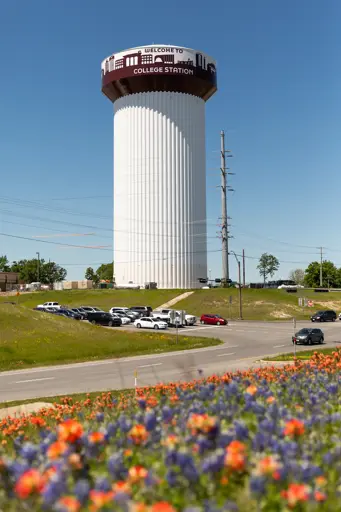Drinking Water
College Station's water system includes over 490 miles of water distribution lines, groundwater wells, pump stations, and two elevated water storage tanks. Our water system is rated "Superior" by the State of Texas and in fact has received awards for outstanding operations and maintenance from the Environmental Protection Agency (EPA).
Water Production
Water Production personnel operate and maintain the City's award-winning groundwater production and transmission system, capable of producing up to 29.5 million gallons of fresh, clean drinking water each day. Click to learn more.
College Station pumps water from deep wells located on city-owned land over the Carrizo-Wilcox Aquifer, in the Carrizo, Sparta, and Simsboro Sand formations. The maximum temperature of the water as pumped from underground is 118 degrees Fahrenheit. To reduce the temperature, the water is pumped through cooling towers at Sandy Point Pump Station, lowering the temperature to below 90 degrees Fahrenheit.
Raw water transmission lines carry the ground water approximately 13 miles from Sandy Point Pump Station to the Dowling Road Pump Station for further treatment. Fortunately, the source water for College Station is clean enough that only chlorine disinfection is needed to treat the water to Safe Drinking Water Act standards.
While no single disinfectant is right for all systems, public water systems in Texas of College Station's size must have some form of chlorine residual to inactivate harmful microorganisms and prevent contamination in the water distribution system. College Station disinfects its drinking water with gas chlorine to provide an effective chlorine residual. The decision of which disinfection method to use must take into account several factors, including source water quality, water treatment goals, regulatory requirements, storage capacity, and cost.
After the water is disinfected, it is pumped into the water distribution system, which includes three elevated storage tanks. The elevated storage tanks provide an adequate supply of water pressure for use in our homes and businesses and fire protection for the residents of College Station.

Backflow Prevention
The Backflow Prevention and Cross-Connection Control program administered by College Station Utilities is an important part of keeping our water supply safe. The City of College Station is required by the Texas Commission on Environmental Quality (TCEQ) to eliminate cross-connections and maintain a Cross-Connection Control Program for the drinking water system in College Station. This program includes the installation and testing of backflow prevention assemblies where deemed appropriate by a certified inspector.Backflow Ordinance (Ch. 40, Article II, Division 6 of the Code of Ordinances)
All lawn irrigation systems must have an installation permit and an approved backflow prevention device. Permits are issued by City of College Station Planning & Development Services.
The backflow prevention device must be tested on installation and the test results must be provided to City of College Station Water Services using the below report form. All installation, inspection, and testing of backflow prevention devices must be performed by an individual certified by the TCEQ as a Backflow Assembly Tester (BPAT). The tester must also be registered with the City of College Station.
List of Registered Backflow Assembly Testers
Backflow Prevention Assembly Test & Maintenance Report
Testers must also supply the original test report to the Water Services within 30 days of testing a backflow device per City Ordinance. Mail report to: Water Services, Attn: Environmental Services, PO Box 9960, College Station, TX 77842. Reports may also be delivered in person to: 1601 Graham Road, College Station, TX 77845.
To register as a BPAT with the City of College Station, a tester must provide:
- A copy of each tester's TCEQ BPAT License.
- A current copy of their gauge calibration certificate.
- Company mailing address, phone number, and email address
- $50 annual registration fee made payable to the City of College Station (cash or check; covers all testers within company)
Why Should you Care about Backflow and Cross-Connections?
Water distribution systems are designed so that water normally flows in only one direction: from the treatment plant to the customer. When water flows in the opposite direction from normal flow, backward through the water supply system, this is a condition known as backflow.
A cross-connectionis any unprotected physical arrangement where a potable water supply is connected directly or indirectly to any other apparatus that could cause any substance other than the City's drinking water to enter the drinking water system.
The most common cross-connection occurs when a hose is connected to a harmful substance. If the pressure in a water main drops while your hose is submerged in polluted or contaminated water, then the water (and whatever is in it) could be sucked back into your pipes and your drinking water supply. The following tips may help to reduce the potential for cross-connections:
- DON'T submerge hoses in buckets, pools, tubs, or sinks.
- DO keep the end of the hose clear of possible contaminants.
- DON'T use spray attachments without a backflow prevention device. The chemicals used on your lawn can be fatal if ingested.
- DO buy and install inexpensive backflow prevention devices for all threaded faucets around your home.
